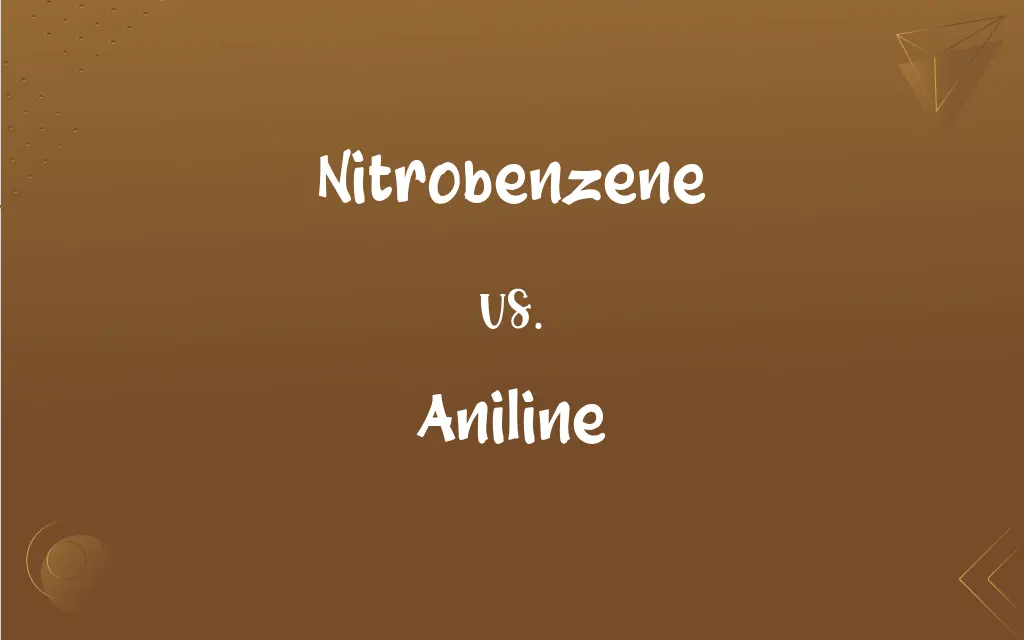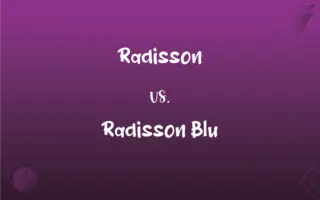Nitrobenzene vs. Aniline: What's the Difference?
Edited by Aimie Carlson || By Janet White || Published on February 16, 2024
Nitrobenzene is a pale yellow, oily liquid with a nitro group attached to benzene, used in synthesis; aniline is a clear to slightly yellow liquid, a benzene derivative with an amino group, used in dyes and drugs.

Key Differences
Nitrobenzene, a pale yellow, oily liquid, is characterized by a nitro group (-NO2) attached to a benzene ring, making it an important industrial chemical. Aniline, a clear to slightly yellow liquid, differs by having an amino group (-NH2) attached to the benzene ring, which confers different chemical properties and uses, notably in the production of dyes.
In terms of production, nitrobenzene is synthesized through the nitration of benzene, a process involving concentrated nitric and sulfuric acids. Aniline is commonly produced by the reduction of nitrobenzene, demonstrating a direct chemical relationship between the two compounds.
Nitrobenzene is primarily used in the synthesis of aniline and is also a precursor to other chemicals, including pharmaceuticals and pesticides. Aniline is extensively used in the manufacture of polyurethane foam, dyes, pharmaceuticals, and rubber chemicals.
From a safety perspective, nitrobenzene is toxic and can cause methemoglobinemia upon exposure. Aniline also poses health risks, as it is toxic and can be absorbed through the skin, causing various health effects.
Chemically, nitrobenzene is less reactive than aniline due to the electron-withdrawing nitro group, which makes the benzene ring less reactive. In contrast, the amino group in aniline is an electron-donating group, making the benzene ring more reactive in certain chemical reactions.
ADVERTISEMENT
Comparison Chart
Chemical Group
Contains a nitro group (-NO2)
Contains an amino group (-NH2)
Appearance
Pale yellow, oily liquid
Clear to slightly yellow liquid
Production
Synthesized via benzene nitration
Produced by reducing nitrobenzene
Primary Uses
Synthesis of aniline, chemicals
Dyes, pharmaceuticals, foam
Chemical Reactivity
Less reactive due to nitro group
More reactive due to amino group
ADVERTISEMENT
Nitrobenzene and Aniline Definitions
Nitrobenzene
A pale yellow, oily liquid used in chemical synthesis.
The factory produces nitrobenzene for various industrial applications.
Aniline
A colorless to slightly yellow liquid used in rubber processing.
Aniline's properties are beneficial in enhancing rubber elasticity.
Nitrobenzene
A benzene derivative important in pharmaceutical manufacturing.
Nitrobenzene serves as a precursor in certain drug formulations.
Aniline
A benzene derivative used in polyurethane foam production.
Aniline is essential in creating certain types of foam insulation.
Nitrobenzene
An organic compound with a nitro group attached to benzene.
Nitrobenzene is used as an intermediate in aniline production.
Aniline
An organic compound with an amino group on a benzene ring.
Aniline is a key ingredient in the production of synthetic dyes.
Nitrobenzene
A compound used in the production of pesticides.
Nitrobenzene's chemical properties make it suitable for pesticide synthesis.
Aniline
A chemical base for pharmaceuticals and photographic chemicals.
Aniline's versatility extends to pharmaceutical and photochemical industries.
Nitrobenzene
A toxic chemical requiring careful handling.
Proper safety measures are essential when working with nitrobenzene.
Aniline
A toxic substance used in the chemical industry.
Despite its toxicity, aniline is widely used in various industrial processes.
Nitrobenzene
A colorless or yellowish poisonous oily liquid, C6H5NO2, having the odor of almonds and used in the manufacture of aniline, insulating compounds, and polishes.
Aniline
A colorless, oily, poisonous benzene derivative, C6H7N, used in the manufacture of rubber, dyes, resins, pharmaceuticals, and varnishes.
Nitrobenzene
(organic compound) A nitro derivative of benzene, C6H5NO2, prepared by reacting benzene with a mixture of nitric and sulphuric acids; any of a series of such compounds having two or more nitro groups
Aniline
Derived from aniline.
Nitrobenzene
A yellow aromatic liquid (C6H5.NO2), produced by the action of nitric acid on benzene, and called from its odor imitation oil of bitter almonds, or essence of mirbane. It is used in perfumery, and is manufactured in large quantities in the preparation of aniline. Fornerly called also nitrobenzol.
Aniline
(organic compound) The simplest aromatic amine, C6H5NH2, synthesized by the reduction of nitrobenzene; it is a colourless oily basic poisonous liquid used in the manufacture of dyes and pharmaceuticals.
Nitrobenzene
A poisonous oily water-soluble liquid used as a solvent and in the manufacture of aniline
Aniline
An organic base belonging to the phenylamines. It may be regarded as ammonia in which one hydrogen atom has been replaced by the radical phenyl. It is a colorless, oily liquid, originally obtained from indigo by distillation, but now largely manufactured from coal tar or nitrobenzene as a base from which many brilliant dyes are made.
Aniline
Made from, or of the nature of, aniline.
Aniline
Oily poisonous liquid amine obtained from nitrobenzene and used to make dyes and plastics and medicines
FAQs
What is the main use of aniline?
Aniline is primarily used in the manufacture of dyes, pharmaceuticals, and polyurethane foam.
How is nitrobenzene produced?
Nitrobenzene is produced by nitrating benzene with concentrated nitric and sulfuric acids.
Are there health risks associated with nitrobenzene?
Yes, nitrobenzene is toxic and can cause methemoglobinemia.
Can aniline be absorbed through the skin?
Yes, aniline is toxic and can be absorbed through the skin, posing health risks.
What safety measures are required for handling nitrobenzene?
Proper protective equipment and ventilation are required due to its toxicity.
Is aniline derived from nitrobenzene?
Yes, aniline is commonly produced by the reduction of nitrobenzene.
What is the appearance of nitrobenzene?
Nitrobenzene is a pale yellow, oily liquid.
Is aniline used in rubber production?
Yes, aniline is used in rubber processing and manufacturing.
What industries use aniline?
Aniline is used in the chemical, dye, pharmaceutical, and rubber industries.
What is nitrobenzene used for?
Nitrobenzene is used in the synthesis of aniline and other chemicals.
Can nitrobenzene be used in pesticide manufacturing?
Yes, nitrobenzene is used in the production of certain pesticides.
Does aniline have a strong odor?
Aniline has a slightly aromatic odor.
Is aniline flammable?
Aniline is flammable and should be handled with care.
What precautions are necessary when using nitrobenzene?
Use in a well-ventilated area and wear appropriate protective gear.
Can aniline be used in foam insulation?
Yes, aniline is essential in the production of certain polyurethane foams.
What does aniline look like?
Aniline is a clear to slightly yellow liquid.
Is nitrobenzene reactive?
Nitrobenzene is less reactive due to its electron-withdrawing nitro group.
How reactive is aniline?
Aniline is more reactive because of its electron-donating amino group.
Is nitrobenzene stable under normal conditions?
Yes, nitrobenzene is generally stable under normal storage conditions.
Can nitrobenzene be used in drug synthesis?
Yes, nitrobenzene is a precursor in certain pharmaceutical formulations.
About Author
Written by
Janet WhiteJanet White has been an esteemed writer and blogger for Difference Wiki. Holding a Master's degree in Science and Medical Journalism from the prestigious Boston University, she has consistently demonstrated her expertise and passion for her field. When she's not immersed in her work, Janet relishes her time exercising, delving into a good book, and cherishing moments with friends and family.
Edited by
Aimie CarlsonAimie Carlson, holding a master's degree in English literature, is a fervent English language enthusiast. She lends her writing talents to Difference Wiki, a prominent website that specializes in comparisons, offering readers insightful analyses that both captivate and inform.































































